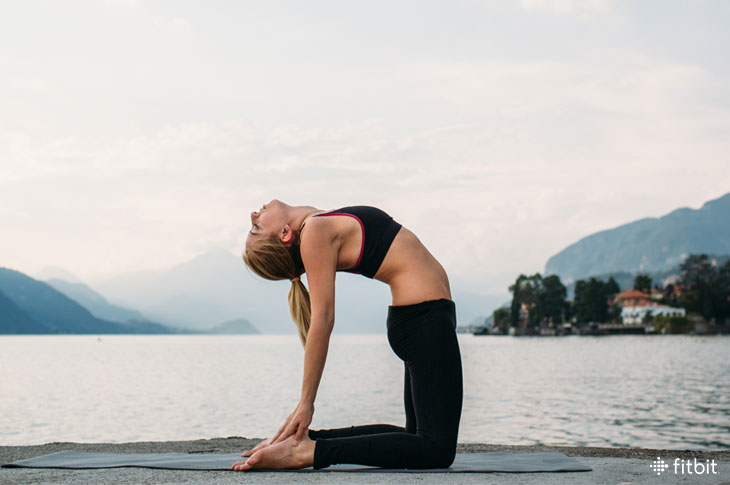
Unless you have an unlimited vacation policy, you likely spend most of your time working at a desk. Fortunately, hitting the yoga mat can help offset related effects, like hunched shoulders and a sore back—not to mention help you shake off your last PowerPoint presentation. Some poses are even designed to ‘open’ you up, mentally and physically. “Placing your body in an elongated shape, like a backbend, completely opens the front line of your body,” says Elizabeth Hinker, E-RYT, Area Leader for CorePower Yoga in Chicago, “and you start to feel the emotional effects as well.”
Along with the physical benefits, like limbering up, research supports yoga’s calming effects,. Emotional benefits haven’t been studied as much, but if you’ve spent any time in a yoga studio, you probably know it feels good. “That’s why you leave a yoga class feeling so energized, balanced, and calm,” says Hinker. Here are three postures that can help you find more freedom on the mat and off.
Camel Pose
Kneel with your knees and shins hip-distance apart. Place your hands on your low back, fingers pointing down. Squeeze your inner thighs toward each other, to create a stable base. (They won’t move, but the muscle engagement and related lift of your pelvic floor—think Kegels, ladies—will support your lower back during the backbend.) Next, inhale, lifting your chest, and gaze up. Exhale and slowly lean and gaze back. Keep your hips lifted over your knees, and your thighs perpendicular to the floor. Either keep your hands at your low back for support, or reach your right hand to your right heel, and left hand to your left heel. Hold for three to five breaths, and continue to lift your chest (and heart!) toward the sky. Rise back to start slowly.
What it opens in your body: Your chest and shoulders—the parts of your body that are typically hunched over a keyboard or steering wheel.
Why it’s awesome for your mind: “Emotionally, Camel opens your heart chakra—an area you often protect,” Hinker says. “So when it’s placed in a physically vulnerable position like Camel, it’s normal to feel a rush of emotions.” Like joy.
Bound Angle Pose (forward fold variation)
Sit on the floor (or on a cushion if your hips feel tight), and touch the soles of your feet together in front of you. For more of a hip stretch, bring your feet closer to your groin, or move them further away for more of a low-back stretch. Hold your feet with your hands, and inhale, lifting your chest and elongating your spine. Exhale and bend forward, bringing your forehead to your feet. Use your elbows to press your knees open, or slide a yoga block underneath each knee, if you need more support. Hold for several breaths to soften into the shape. Support your forehead with pillows or blocks if you feel uncomfortable with your head hovering in space.
What it opens in your body: Your low back and hips, which get tight and achy whether you spend lots of time sitting, running, or biking.
Why it’s awesome for your mind: “Bound Angle Pose helps stimulate and balance the first (Muladahara) and second (Svadisthana) chakras, which relate to grounding and creativity,” Hinker says. “If you’re feeling scattered by the change of season, this pose can help you feel more rooted. And if you’re feeling stagnant with a work project or in a relationship, this can help fuel the creative fire.”
Revolved Head to Knee
Sit on the floor in a wide V, with your legs extended to either side. Bend your left knee, and place the sole of your left foot along your inner right thigh. Place your right forearm on your right shin and reach your left arm up and overhead, and bend sideways toward your right pinky toe. Continue to ground both hips down into the floor. Lengthen along the sides of your body as you bend toward the right side. Hold the pose for five to 10 breaths. Repeat on the opposite side for the same amount of time.
What it opens in your body: The entire sides of your body, from your hips through your shoulders, along with the hamstrings of your extended leg. “Stretching these muscles increases mobility in your spine and shoulders, which makes you feel more ease within your body,” Hinker says.
Why it’s awesome for your mind: “Bending both right and left can also help balance both sides of your ‘energetic body,’” Hinker says. This incorporates ancient Eastern concepts, like warming and cooling energy, yin and yang, and feminine and masculine energy. “It can help you feel more open and balanced overall,” says Hinker.
This information is for educational purposes only and is not intended as a substitute for medical diagnosis or treatment. You should not use this information to diagnose or treat a health problem or condition. Always check with your doctor before changing your diet, altering your sleep habits, taking supplements, or starting a new fitness routine.

Pictures of the poses would be helpful
I concur.
Great post! Do you have something interesting about kundalini yoga? I’m new to this and I really wanna know more…
Thanks
This is a really useful and interesting article, thank you for sharing it. My friend from the essay writing service started yoga to improve her mental abilities. She says that before the working day there is nothing better than 20 minutes to work out with yoga, it helps to relax and tune in to work. In a short time she plans to go to India to see the real masters in this field and learn a lot of interesting things. I would really like to see on your website a new article on the benefits of yoga for writers. It would be wonderful.